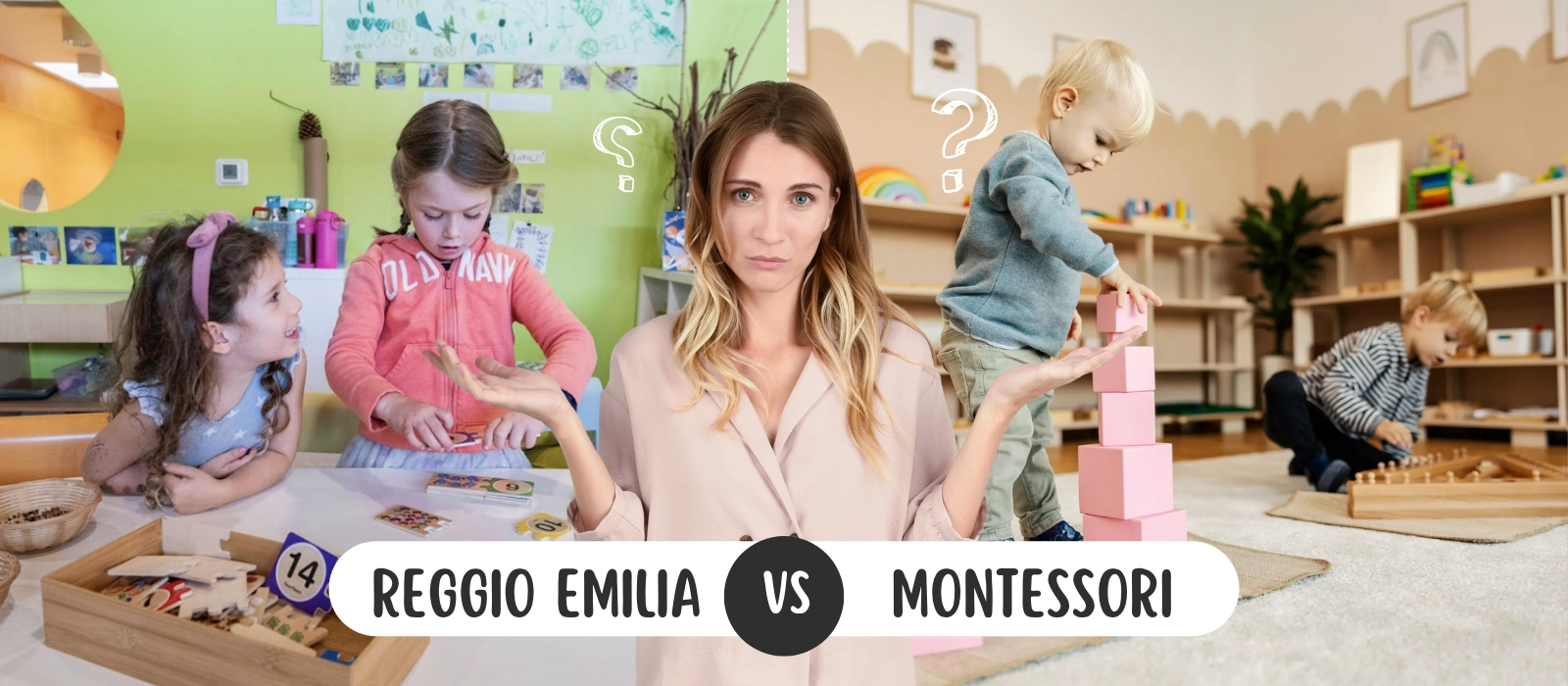Are you struggling to decide between the Reggio Emilia approach vs Montessori for your child’s education? With so many educational philosophies available, it can be overwhelming to determine which method will provide the best environment for your child’s development. How do the Reggio Emilia vs Montessori approaches differ, and how can you decide which one will foster your child’s creativity, independence, and overall growth?
The main difference between the Reggio Emilia vs Montessori approaches lies in their teaching philosophy and classroom environment. Reggio Emilia emphasizes creativity, self-expression, and community involvement, offering a dynamic, project-based curriculum that evolves based on children’s interests. It focuses on collaboration and artistic exploration. In contrast, Montessori fosters independence, structured learning, and hands-on experiences within a prepared environment, where children work at their own pace. Both approaches are child-centered but offer different methods to nurture a child’s intellectual and emotional growth.
Now that you have a clearer picture, let’s explore the core principles of both the Reggio Emilia and Montessori philosophies, and discover which educational approach is best suited for your child’s journey towards growth and development.
The History of the Reggio Emilia Approach

When comparing Reggio Emilia vs Montessori, let’s start by exploring the history of both approaches. The Reggio Emilia approach originated in the town of Reggio Emilia, Italy, after World War II, thanks to the visionary work of educator Loris Malaguzzi. In the wake of the war, the local community, led by parents and teachers, sought to rebuild the educational system, focusing on a new vision of childhood that valued the voice, rights, and potential of each child. The Reggio Emilia philosophy was built on the belief that children are not just passive recipients of knowledge, but active participants in constructing their learning.
The Reggio Emilia approach originated in the town of Reggio Emilia, Italy, after World War II, thanks to the visionary work of educator Loris Malaguzzi. In the wake of the war, the local community, led by parents and teachers, sought to rebuild the educational system, focusing on a new vision of childhood that valued the voice, rights, and potential of each child.
The Reggio Emilia philosophy was built on the belief that children are not just passive recipients of knowledge, but active participants in constructing their learning.
The History of the Montessori Method
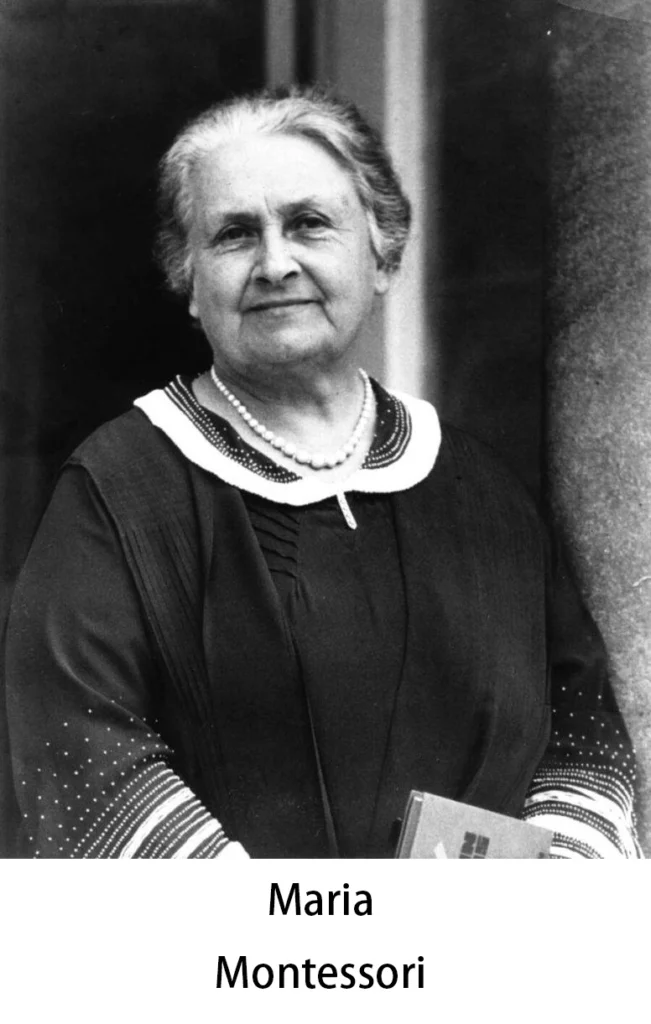
When comparing Reggio Emilia vs Montessori, let’s start by exploring the history of both approaches. The Montessori method was developed by Dr. Maria Montessori in the early 1900s. Dr. Montessori, an Italian physician and educator, began her work with children in a poor area of Rome, where she observed that children were most successful in learning when given the freedom to explore and engage with their environment independently. She created a carefully structured, self-directed learning environment designed to foster independence, creativity, and critical thinking.
The Montessori method emphasizes the importance of respecting the child as an individual, allowing them to learn at their own pace and develop their own interests. Over time, Montessori education spread across the world, with schools established in various countries.
Today, Montessori schools are known for their structured curriculum and emphasis on academic readiness. Montessori vs Reggio Emilia continues to be a key point of discussion, as parents and educators assess which approach best supports their child’s growth.
Key Principles of the Reggio Emilia Approach
1. Children’s Learning is Based on Their Interests
In the Reggio Emilia approach, children’s learning is driven by their interests. Instead of following a fixed curriculum, teachers observe children to identify their passions and create projects around these interests. This approach fosters deep engagement, as children explore topics they are genuinely curious about, leading to meaningful, hands-on learning experiences. When comparing Reggio Emilia vs Montessori, both methods emphasize child-centered learning, but Reggio Emilia is more flexible, focusing on projects that evolve with the children’s interests.
For example, if children are fascinated by insects, the teacher might guide them in exploring this topic through discussions, activities, and observation. This method ensures that learning is relevant and personalized, encouraging a love for discovery and critical thinking.
2. Teachers and Parents are Co-Learners in the Reggio Emilia Approach to Early Childhood Education
In Reggio Emilia, teachers and parents are seen as co-learners. Teachers observe and guide children’s learning, while parents actively participate in the process, providing insights into the child’s interests and development. This collaboration strengthens the child’s educational experience and ensures that learning extends beyond the classroom. In comparison to Montessori, where parents support their children’s independence at home, Reggio Emilia encourages a more community-driven approach with significant parental involvement in the learning process.
Parents are invited to share their expertise, contribute to classroom projects, and engage in regular communication with educators. This partnership fosters a strong community around each child’s growth.
3. The Classroom Environment is a “Third Teacher”
In Reggio Emilia, the classroom environment is considered the “third teacher.” The space is thoughtfully designed to encourage exploration and creativity. It features open-ended materials, natural lighting, and flexible furniture that can be rearranged to support various activities. When looking at Reggio Emilia vs Montessori, Reggio Emilia stands out for its dynamic and visually engaging environment, which fosters a more collaborative and artistic approach to learning.
This environment invites children to interact with materials and each other, promoting independent exploration and collaborative learning. It’s not just about decoration; the environment plays an active role in stimulating curiosity and supporting the child’s learning journey.
4. Children’s Learning Progress is Documented
In Reggio Emilia, children’s learning is documented through photos, notes, and work samples. This documentation helps teachers track progress, reflect on teaching methods, and share the learning journey with parents. Unlike the Montessori approach, where children’s progress is often tracked through milestones, Reggio Emilia emphasizes a more visual and reflective method of documentation to showcase the child’s thought processes and growth.
It allows children to see their own growth and fosters a deeper connection to their learning. By making the process visible, children gain a sense of pride and ownership in their work, while teachers and parents can support and celebrate their progress.
5. Teachers Focus on the Many Ways Kids Learn
The Reggio Emilia approach recognizes that children learn in many ways, including through speech, art, movement, and play. Teachers encourage children to express themselves in various forms, whether through drawing, building, or acting out ideas. When considering Reggio Emilia vs Montessori, the focus on multiple modes of expression in Reggio Emilia gives children the freedom to explore their ideas in diverse ways, whereas Montessori tends to focus more on hands-on, structured activities.
By supporting multiple modes of expression, Reggio Emilia ensures that all children can communicate their thoughts and understand the world in their own unique ways, fostering creativity and critical thinking.
Key Principles of the Montessori Method
1. Freedom
Freedom is central to the Montessori method and contrasts with the more collaborative structure found in Reggio Emilia vs Montessori approaches. In Montessori, children are given the freedom to choose their activities, work at their own pace, and explore topics that interest them. This autonomy fosters self-motivation, independence, and responsibility, with children encouraged to make decisions and solve problems independently. Unlike the Reggio Emilia approach, which is more project-driven and community-focused, Montessori emphasizes individual learning within a structured environment.
2. Structure and Order
In Montessori, structure and order create an environment that supports independent learning, contrasting with the fluidity seen in Reggio Emilia vs Montessori. Montessori classrooms are meticulously organized, with each material in its specific place to promote focus and responsibility. This structured environment helps children learn to care for their space and stay focused on tasks. While Reggio Emilia fosters a more flexible environment driven by children’s interests, Montessori ensures that children develop discipline and independence through clear organization.
3. Beauty
Beauty in the Montessori method emphasizes an aesthetically pleasing and orderly environment, which helps children engage with the learning materials. This principle differs from Reggio Emilia vs Montessori, where Reggio Emilia places more emphasis on creativity and artistic expression. In Montessori, natural materials such as wood and metal are used to create a harmonious learning environment, supporting concentration and respect. The beauty of the surroundings encourages children to engage with their tasks thoughtfully, fostering a deep connection with their work.
4. Nature and Reality
The principle of nature and reality is emphasized in both Reggio Emilia vs Montessori, but it manifests differently in each approach. In Montessori, children engage with real-life tasks such as gardening or cooking, helping them connect to the practical world around them. The Reggio Emilia approach, on the other hand, also values nature but focuses more on creative and artistic exploration of the environment. Both approaches seek to help children understand their world, but Montessori emphasizes practical life skills, while Reggio Emilia encourages expressive learning through nature.
5. Social Environment
In the Montessori method, the social environment is structured to encourage independence and responsibility. While children interact with peers, the emphasis is on individual work and self-direction. This contrasts with the more community-focused Reggio Emilia vs Montessori comparison, where Reggio Emilia emphasizes collaboration, group work, and social engagement. In Montessori, mixed-age classrooms allow older children to mentor younger ones, fostering leadership skills and empathy. Both methods promote social development, but Reggio Emilia places a stronger focus on collective experiences and peer interactions.
6. Intellectual Environment
The intellectual environment in both Reggio Emilia vs Montessori approaches supports children’s learning, but with different focuses. In Montessori, children explore subjects like math, language, and science through hands-on materials, promoting self-directed learning. Teachers act as guides, offering support when needed. In Reggio Emilia, the intellectual environment is more fluid, with learning often driven by projects and children’s interests. While Montessori focuses on structured learning with clear goals, Reggio Emilia encourages a more exploratory, inquiry-based approach to intellectual development.
Comparing Classroom Environments: Reggio Emilia vs Montessori
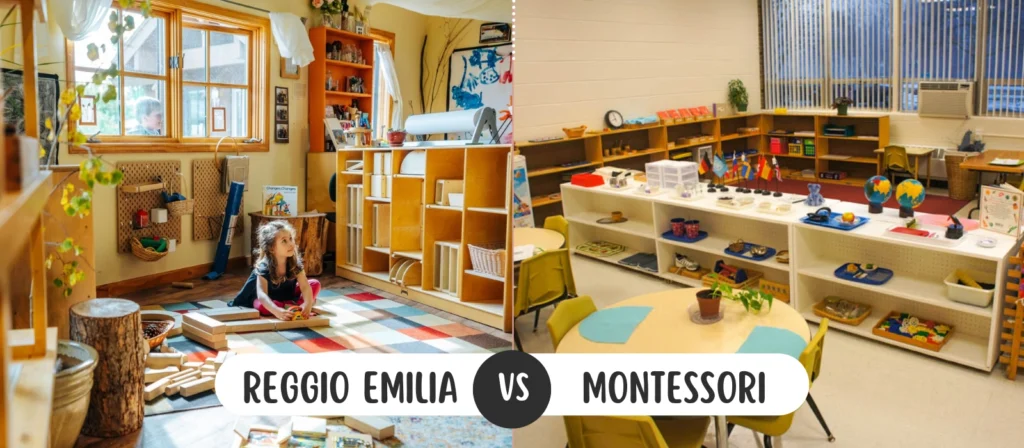
When comparing the classroom environments of Reggio Emilia vs Montessori, the differences are striking yet complementary. In a Reggio Emilia classroom, the environment is dynamic and fluid, designed to foster collaboration, creativity, and exploration. The classroom is often filled with open-ended materials that invite children to experiment and discover. The design of the space encourages children to work in small groups and engage in projects that reflect their interests.
In contrast, Montessori classrooms are highly organized, with specific areas dedicated to different developmental activities, such as practical life skills, sensory development, and math. The materials in Montessori classrooms are carefully selected to promote independent learning. Each piece of equipment has a specific purpose, designed to help children master a skill at their own pace. While both approaches create nurturing environments, Montessori’s structured setup contrasts with the more flexible, fluid atmosphere found in Reggio Emilia classrooms.
Both environments prioritize independence, but Reggio Emilia emphasizes community and collaborative work, whereas Montessori focuses more on individual autonomy and self-direction.
Role of the Teacher in Reggio Emilia vs Montessori
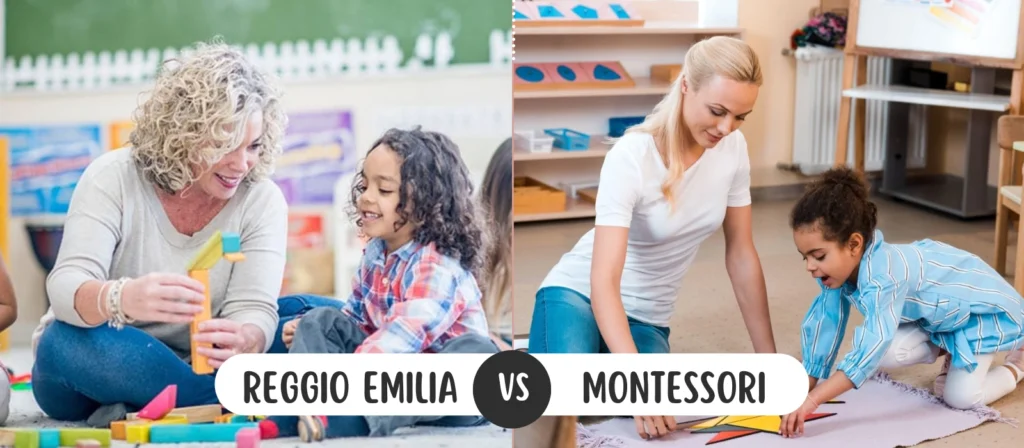
The role of the teacher in both Reggio Emilia vs Montessori approaches is to support and guide children’s learning, but their methods and involvement vary.
In Reggio Emilia, teachers are seen as co-learners or facilitators, working alongside children as they explore and develop their ideas. Teachers observe children closely, document their work, and provide resources or suggestions to deepen their investigations. The teacher’s role is dynamic, adjusting based on the children’s needs and interests.
In Montessori, the teacher is also a guide but plays a more passive role compared to the Reggio Emilia approach. Montessori educators observe the child’s progress and intervene only when necessary. They prepare the environment and provide materials, but much of the learning is child-directed. The focus is on nurturing independence and allowing children to take responsibility for their own learning.
Curriculum and Learning Outcomes in Reggio Emilia vs Montessori
Both Reggio Emilia vs Montessori approaches prioritize child-centered learning, but the curriculum and learning outcomes differ in key ways.
In Reggio Emilia, the curriculum is flexible and emerges from the children’s interests. Long-term projects are a hallmark of this approach, allowing children to explore a subject in depth over a period of time. The focus is on the process of learning rather than on achieving specific academic outcomes. Reggio Emilia schools place a strong emphasis on the development of social skills, emotional intelligence, and creative expression.
On the other hand, the Montessori curriculum is structured to follow specific developmental milestones. It is highly organized and consists of clear learning objectives that guide the child’s progress through various stages. The Montessori method focuses on individual growth, encouraging children to master specific skills before moving on to more complex tasks. Montessori schools are known for their emphasis on academic readiness, especially in areas like math, language, and practical life skills.
Parental Involvement in Reggio Emilia vs Montessori
Parental involvement plays a significant role in both Reggio Emilia vs Montessori approaches, although the way it is encouraged varies.
In Reggio Emilia, parents are viewed as active participants in the educational process. Teachers regularly communicate with parents about their child’s progress and encourage them to participate in projects and classroom activities. Parents are also invited to share their knowledge and expertise, contributing to the learning process and the community aspect of the classroom.
In Montessori, parental involvement is also valued but typically focuses more on supporting the child’s learning at home. Montessori educators encourage parents to foster independence in their children and to reinforce the concepts learned in school. However, Montessori classrooms are designed to promote self-sufficiency, and there is less emphasis on parents directly participating in classroom activities compared to Reggio Emilia.
Furniture in Reggio Emilia vs Montessori
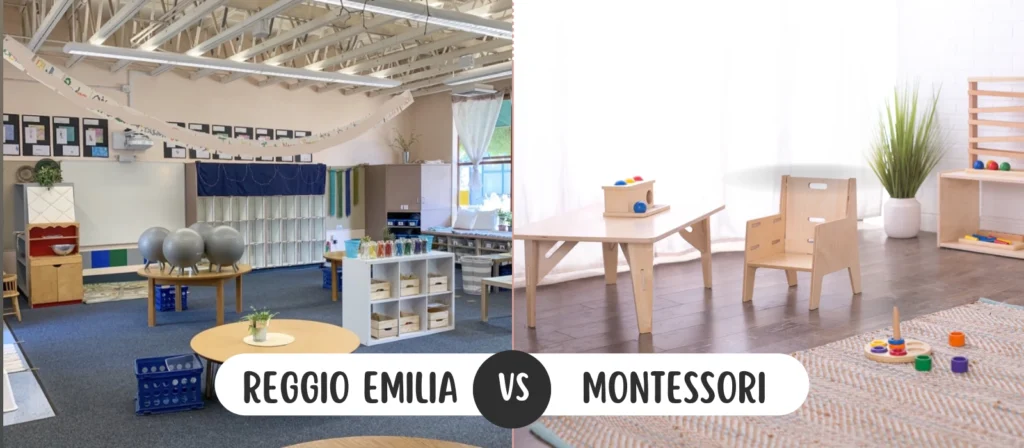
The design of furniture in Reggio Emilia vs Montessori classrooms plays an important role in creating environments that support the learning needs of young children. While both educational philosophies prioritize a well-organized, accessible, and child-centered space, the types of furniture used are tailored to their specific educational goals.
In Reggio Emilia, furniture is typically flexible, designed to allow children to move freely and interact with their environment in creative ways. Reggio Emilia furniture is often low to the ground, child-sized, and made from natural materials like wood, providing a tactile experience for children. The focus is on creating a warm, aesthetically pleasing environment that fosters collaboration, imagination, and exploration. Furniture is often modular, allowing it to be rearranged easily to support various activities and groupings. This flexible approach encourages children to engage with the space in a dynamic way, promoting creativity and social interaction.
In Montessori, the furniture is more structured and purposeful, emphasizing independence and self-sufficiency. Montessori furniture is designed to support a child’s ability to independently select and use materials. Shelves are low and open, allowing children to easily access their learning tools. Each piece of furniture in a Montessori classroom serves a functional purpose, with a focus on creating a sense of order and organization. The environment encourages children to take responsibility for their surroundings, whether it’s putting materials back on the shelves or choosing what to work on next. Montessori furniture is simple, clean, and practical, reinforcing the principle of minimalism and self-direction.
While both systems prioritize furniture that is child-centered, Reggio Emilia focuses on creating a rich, collaborative space, while Montessori emphasizes functionality and independence.
Toys in Reggio Emilia vs Montessori
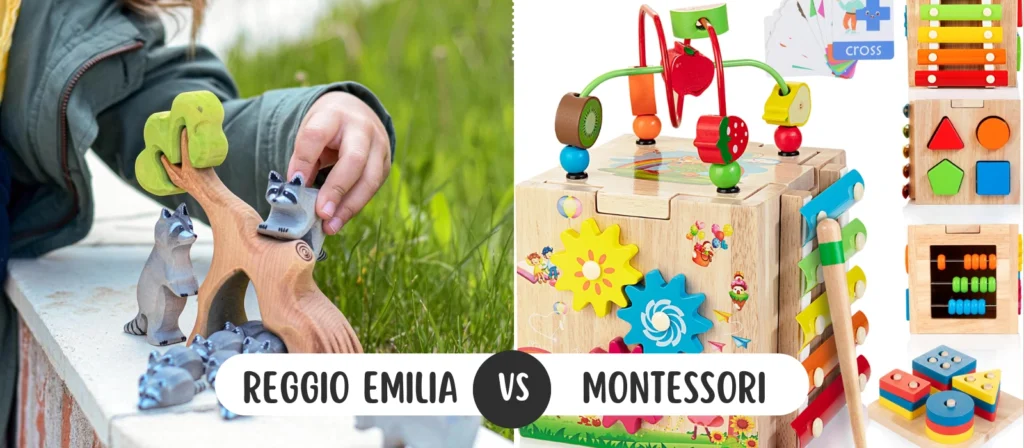
When it comes to toys in the classroom, both Reggio Emilia vs Montessori approaches focus on fostering the development of key skills such as creativity, independence, and problem-solving. However, the types of toys used, as well as their intended purposes, differ significantly between the two.
In Reggio Emilia, toys are open-ended and designed to stimulate a child’s imagination. The materials used are often natural and simple, such as wooden blocks, fabric, and clay. These toys are meant to be used in a variety of ways, promoting creativity and self-expression. The focus is on providing children with materials that encourage exploration and experimentation. In Reggio Emilia classrooms, toys are often integrated into long-term projects, allowing children to use them in different contexts to deepen their learning. This approach encourages children to interact with their peers, collaborate, and express their ideas through play. Reggio Emilia toys are tools for both individual and social development, allowing children to communicate, negotiate, and reflect on their experiences.
In Montessori, toys are more structured and specific to a particular learning goal. Montessori toys are designed to teach particular concepts or skills, such as building, sorting, matching, or counting. These toys are often self-correcting, meaning that children can solve problems independently without needing the intervention of an adult. Montessori materials include items like the pink tower (for spatial reasoning) or the knobbed cylinders (for fine motor skills), all of which encourage hands-on, independent learning. Montessori toys are generally made from high-quality natural materials, like wood or metal, and are designed to engage a child’s senses while promoting concentration and precision.
The key difference between Reggio Emilia vs Montessori toys is their intended use. Reggio Emilia toys are open-ended and encourage collaborative play and creativity, while Montessori toys are structured to help children develop specific skills and abilities independently. Both methods, however, provide children with valuable opportunities for growth through play.
Differences in Social and Emotional Development: Reggio Emilia vs Montessori
The way Reggio Emilia vs Montessori approaches foster social and emotional development differs, with both methods offering unique benefits for children.
In Reggio Emilia, children are encouraged to explore relationships and work collaboratively, emphasizing the importance of community and shared experiences. Social skills such as communication, negotiation, and empathy are built through group projects and shared activities. Reggio Emilia schools often create an environment where children learn to express their feelings and work through conflicts, which helps develop strong emotional intelligence.
In Montessori, social and emotional development is also a focal point, though the approach differs in its structure. Montessori education encourages independence, with children often working individually or in small groups. Emotional growth is supported through self-discipline and responsibility, as children are expected to manage their own work, time, and behavior. The Montessori approach also fosters peer learning, where older children mentor younger ones, contributing to emotional growth through leadership roles.
The Importance of Play in Reggio Emilia vs Montessori
Play is an essential part of early childhood education, and both Reggio Emilia vs Montessori approaches emphasize its importance but in different ways.
In Reggio Emilia, play is viewed as a vital tool for learning, where children engage in projects that allow them to express their ideas, test hypotheses, and develop problem-solving skills. The environment is designed to encourage open-ended play that evolves based on the child’s interests. Teachers often observe and document the child’s play, which helps to deepen their understanding and informs the next stages of learning.
In Montessori, play is also important, but it tends to be more structured with specific educational goals. Montessori toys and materials are designed to engage children in independent play that fosters concentration and fine motor skills. The Montessori method supports purposeful play, where children explore concepts such as counting, sorting, and matching through hands-on activities. While both approaches value the role of play in learning, Reggio Emilia focuses on open-ended play, while Montessori emphasizes play that supports specific developmental milestones.
The Role of Nature in Reggio Emilia vs Montessori
Nature plays a key role in both Reggio Emilia vs Montessori approaches, but each philosophy incorporates nature in its own way.
In Reggio Emilia, the natural world is seen as an extension of the classroom, and children are encouraged to explore their surroundings through nature-based activities. Outdoor environments, including gardens and natural playgrounds, are often integrated into the curriculum. Reggio Emilia schools encourage children to use natural materials in their projects, such as wood, clay, and stones, which connects them to the environment and sparks curiosity about the world around them.
Similarly, Montessori also integrates nature into the learning process, but it focuses more on providing children with practical life skills that are connected to the environment. Montessori classrooms often feature gardening activities, caring for plants, and cleaning up the environment. The Montessori method helps children understand the importance of taking care of nature while building a sense of responsibility and environmental stewardship.
The Global Reach of Reggio Emilia vs Montessori
Both Reggio Emilia vs Montessori have gained significant international recognition and are practiced in schools across the globe. Understanding the global reach and how these approaches are adapted in different cultural contexts can give insight into their effectiveness.
Reggio Emilia has spread worldwide, especially in Europe and North America, and it is often implemented in public and private preschool settings. Reggio Emilia schools are known for their flexibility, allowing teachers to tailor the curriculum to local cultures and communities. This adaptability has made the approach highly popular in a variety of international settings, where the focus on collaboration and child-led inquiry resonates with diverse cultural values.
Montessori, on the other hand, has a broad international presence, with thousands of schools operating across continents. The structured, methodical approach of Montessori education makes it easily replicable in different cultural settings, from Asia to Africa. The Montessori method has been especially influential in developing countries, where it offers an affordable, effective educational model that focuses on early childhood development.
Cost and Accessibility: Reggio Emilia vs Montessori
When choosing between Reggio Emilia vs Montessori, cost and accessibility are key factors for many families. Both methods have different pricing structures and can vary greatly in terms of availability.
Reggio Emilia schools tend to be more common in Europe and North America, but they can be costly due to the need for specially trained teachers and the individualized approach to learning. The expense of providing an environment rich in materials, projects, and community involvement can also increase the cost of tuition. However, some Reggio Emilia schools offer financial aid or have public education options available, making it more accessible to a wider range of families.
Montessori schools, on the other hand, are more widely available and can range from affordable public options to private institutions with higher tuition costs. Montessori education is known for being more adaptable, allowing for a greater variety of implementation models. This makes it a more accessible choice for many families, particularly in areas where Montessori schools have been established as part of public education systems. However, the cost of Montessori schools can also vary significantly based on location and school facilities.
Long-Term Benefits: Reggio Emilia vs Montessori
Looking at the long-term benefits of both Reggio Emilia vs Montessori approaches, we can see how each method impacts a child’s educational journey beyond early childhood.
Reggio Emilia fosters creativity, problem-solving, and social-emotional skills, which benefit children as they progress through their education. Children who have been educated in a Reggio Emilia setting often develop a love for learning, strong communication skills, and the ability to work collaboratively in teams. These qualities are highly valued in modern education and can contribute to success in both academic and professional fields.
Montessori emphasizes independence, self-discipline, and academic readiness, which sets children up for success as they transition into higher levels of education. Montessori-trained children are often seen as self-motivated, responsible, and confident in their abilities. The method’s focus on self-directed learning equips children with the tools to navigate complex tasks, solve problems independently, and develop critical thinking skills that will serve them throughout their lives.
Pros and Cons of Reggio Emilia vs Montessori Approaches
Both Reggio Emilia vs Montessori approaches offer valuable benefits, but there are also limitations to consider.
Pros of Reggio Emilia:
- Fosters creativity and self-expression.
- Encourages collaboration and community engagement.
- Provides a flexible and dynamic learning environment.
- Emphasizes the process of learning rather than the outcome.
Cons of Reggio Emilia:
- Can be less structured, making it challenging for children who thrive in a more organized environment.
- Requires highly trained and dedicated teachers to implement effectively.
Pros of Montessori:
- Promotes independence and self-discipline.
- Provides a structured, organized environment for focused learning.
- Emphasizes hands-on learning and self-correction.
Cons of Montessori:
- Can be rigid and less flexible compared to Reggio Emilia.
- Some children may find the individual learning approach isolating.
Real-Life Success Stories: Reggio Emilia vs Montessori

When it comes to the impact of Reggio Emilia vs Montessori education methods, several well-known individuals have publicly credited these educational philosophies for shaping their development and success.
One of the most famous examples is Jeff Bezos, the founder of Amazon. Bezos attended a Montessori school during his early childhood, and he has often shared how the independence and self-directed learning he experienced there helped fuel his entrepreneurial spirit and curiosity. In numerous interviews, Bezos has emphasized how the Montessori philosophy of encouraging children to learn through exploration and problem-solving played a significant role in shaping his innovative mindset. His story demonstrates how the Montessori approach fosters creativity, resilience, and leadership skills that can impact not only personal development but also professional success.
Another influential figure is Giorgio Armani, the world-renowned Italian fashion designer. Armani’s early education was shaped by the Reggio Emilia approach, which emphasizes creativity, self-expression, and collaboration. He has mentioned how these early experiences, particularly the focus on artistic expression and community involvement, had a profound impact on his design philosophy. The values of creativity and independence that were nurtured in his early years are still reflected in his groundbreaking fashion designs, showcasing how the Reggio Emilia approach can foster a child’s artistic vision and innovative thinking.
These examples of Jeff Bezos and Giorgio Armani highlight the profound impact that both Reggio Emilia vs Montessori educational methods can have on individuals across various industries, demonstrating how these approaches nurture creativity, leadership, and a strong sense of independence—qualities that contribute to their long-term success.
Conclusion: Choosing the Right Approach for Your Child
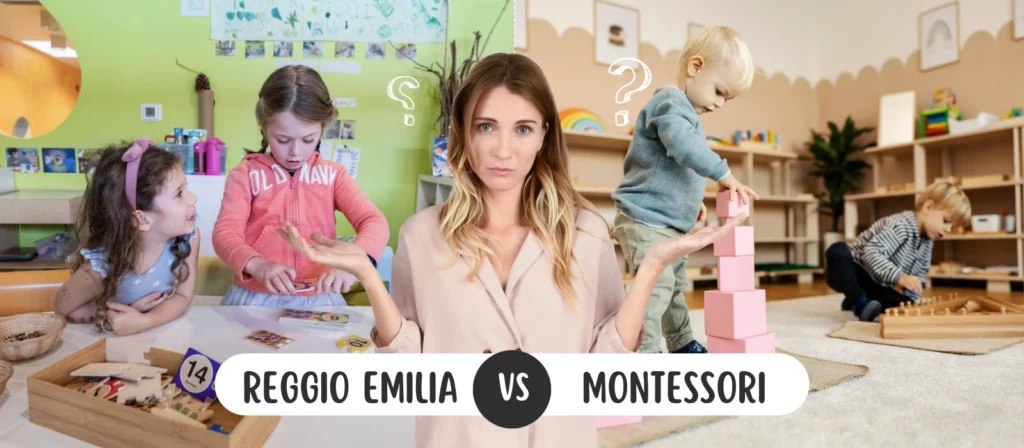
In conclusion, both Reggio Emilia vs Montessori offer unique and powerful approaches to early childhood education, each nurturing essential skills in young children in its own distinct way. While Reggio Emilia focuses on fostering creativity, self-expression, and collaboration, creating an environment where children can explore their ideas freely, Montessori emphasizes independence, self-discipline, and hands-on learning through structured activities.
As you consider which method is best for your child, it’s important to reflect on their personality, learning style, and developmental needs. Reggio Emilia vs Montessori is not just a debate about educational philosophy; it’s about finding the right fit for your child’s growth. Whether your child thrives in the creative, community-driven environment of Reggio Emilia, or in the self-directed, independent learning space offered by Montessori, both approaches aim to empower children to become confident, capable learners.

